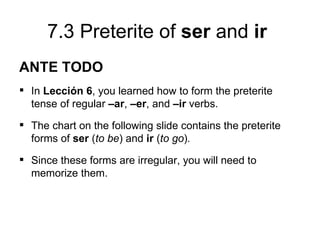7.3 Preterite of ser and ir
•
5 likes•38,818 views
Preterite of ser and ir
Report
Share
Report
Share

More Related Content
What's hot (20)
Similar to 7.3 Preterite of ser and ir
Similar to 7.3 Preterite of ser and ir (20)
¡Inténtalo!Completa las oraciones usando el pretérito de ser o ir..docx

¡Inténtalo!Completa las oraciones usando el pretérito de ser o ir..docx
PowerPoint Pretérito perfecto simple y pretérito imperfecto

PowerPoint Pretérito perfecto simple y pretérito imperfecto
VERBOS PRACTICAS DEL LENGUAJE EDIBA 2020.pdf · versión 1.pdf

VERBOS PRACTICAS DEL LENGUAJE EDIBA 2020.pdf · versión 1.pdf
More from aperlick
More from aperlick (20)
Recently uploaded
Recently uploaded (20)
Prueba de evaluación Geografía e Historia Comunidad de Madrid 2º de la ESO

Prueba de evaluación Geografía e Historia Comunidad de Madrid 2º de la ESO
PINTURA DEL RENACIMIENTO EN ESPAÑA (SIGLO XVI).ppt

PINTURA DEL RENACIMIENTO EN ESPAÑA (SIGLO XVI).ppt
Concepto y definición de tipos de Datos Abstractos en c++.pptx

Concepto y definición de tipos de Datos Abstractos en c++.pptx
2 REGLAMENTO RM 0912-2024 DE MODALIDADES DE GRADUACIÓN_.pptx

2 REGLAMENTO RM 0912-2024 DE MODALIDADES DE GRADUACIÓN_.pptx
Prueba de evaluación Geografía e Historia Comunidad de Madrid 4ºESO

Prueba de evaluación Geografía e Historia Comunidad de Madrid 4ºESO
SESION DE PERSONAL SOCIAL. La convivencia en familia 22-04-24 -.doc

SESION DE PERSONAL SOCIAL. La convivencia en familia 22-04-24 -.doc
Los avatares para el juego dramático en entornos virtuales

Los avatares para el juego dramático en entornos virtuales
Prueba libre de Geografía para obtención título Bachillerato - 2024

Prueba libre de Geografía para obtención título Bachillerato - 2024
7.3 Preterite of ser and ir
- 1. 7.3 Preterite of ser and ir ANTE TODO In Lección 6, you learned how to form the preterite tense of regular –ar, –er, and –ir verbs. The chart on the following slide contains the preterite forms of ser (to be) and ir (to go). Since these forms are irregular, you will need to memorize them.
- 2. 7.3 Preterite of ser and ir ser (to be) ir (to go) SINGULAR FORMS yo fui fui tú fuiste fuiste Ud. /él / ella fue fue PLURAL FORMS nosotros/as fuimos fuimos vosotros/as fuisteis fuisteis Uds. /ellos / ellas fueron fueron
- 3. 7.3 Preterite of ser and ir ¡ATENCIÓN! Note that, whereas regular –er and –ir verbs have accent marks in the yo and Ud. forms of the preterite, ser and ir do not.
- 4. 7.3 Preterite of ser and ir Since the preterite forms of ser and ir are identical, context clarifies which of the two verbs is being used. Él fue a comprar champú y jabón. He went to buy shampoo and soap. —¿Cómo fue la película anoche? —How was the movie last night?
- 5. 7.3 Preterite of ser and ir ¡INTÉNTALO! Completa las siguientes frases usando el pretérito de ser e ir. ir ser 1. Los viajeros ____ a Perú. 1. Usted ____ muy amable. 2. Patricia ____ a Cuzco. 2. Yo ____ muy cordial. 3.Tú ____ a Iquitos. 3. Ellos ____ muy simpáticos. 4. Gregorio y yo ____ a Lima. 4. Nosotros ____ muy desagradables. 5. Yo ____ a Trujillo. 5. Ella ____ muy antipática. 6. Ustedes ____ a Arequipa. 6. Tú ____ muy chistoso. 7. Mi padre ____ a Lima. 7. Ustedes ____ muy cordiales. 8. Nosotras ____ a Cuzco. 8. La gente ____ muy agradable. 9. Él ____ a Machu Picchu. 9. Tomás y yo ____ muy corteses. 10. Usted ____ a Nazca. 10. Los profesores ____ muy buenos.
- 6. 7.3 Preterite of ser and ir Answer Key ir ser 1. Los viajeros fueron a Perú. 1. Usted fue muy amable. 2. Patricia fue a Cuzco. 2. Yo fui muy cordial. 3.Tú fuiste a Iquitos. 3. Ellos fueron muy simpáticos. 4. Gregorio y yo fuimos a Lima. 4. Nosotros fuimos muy desagradables. 5. Yo fui a Trujillo. 5. Ella fue muy antipática. 6. Ustedes fueron a Arequipa. 6. Tú fuiste muy chistoso. 7. Mi padre fue a Lima. 7. Ustedes fueron muy cordiales. 8. Nosotras fuimos a Cuzco. 8. La gente fue muy agradable. 9. Él fue a Machu Picchu. 9. Tomás y yo fuimos muy corteses. 10. Usted fue a Nazca. 10. Los profesores fueron muy buenos.